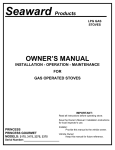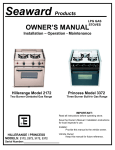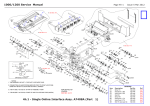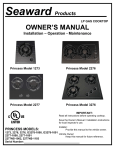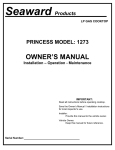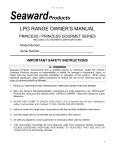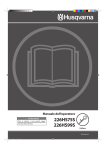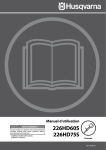Download Seaward HILLERANGE 2423 Owner`s manual
Transcript
Seaward Products LP GAS COOKTOP OWNER’S MANUAL Installation – Operation - Maintenance HILLERANGE Model: 2423 GIMBALLED GALLEY STOVE IMPORTANT: HILLERANGE MODEL: Read all instructions before operating cooktop. 2423-2001 Save the Owner’s Manual / Installation instructions for local inspector’s use. Installer: Provide this manual to the vehicle owner. Vehicle Owner: Keep this manual for future reference. Serial Number: WARNING If the information in this manual is not followed exactly, a fire or explosion may result causing property damage, personal injury or death. FOR YOUR SAFETY Do not store or use gasoline or other flammable vapors and liquids in the vicinity of this or any other appliance. WHAT TO DO IF YOU SMELL GAS • • • • • Evacuate all persons from vehicle. Shut off the gas supply at the gas container or source. Do not touch any electrical switch, or use any phone or radio in the vehicle. Do not start the vehicle’s engine or electrical generator. Contact the nearest gas supplier or qualified service technician, contac nearest fire department. • Do not turn on the gas supply until the gas leak(s) has been repaired. Installation and service must be performed by a qualified installer, service agency or the gas supplier. FIRE HAZARD Do not obstruct the flow of combustion and ventilation air. PERSONAL INJURY HAZARD To eliminate the risk of burns or fire by reaching over heated surface units, cabinet storage space located above the surface unit should be avoided. If cabinet space is to be provided, the risk can be reduced by installing a range hood that projects horizontally a minimum of 5 inches beyond the bottom of the cabinets. Reaching over a heated cooking surface could result in a serious burn or other personal injury. CARBON MONOXIDE POISONING • Do not use any cooking appliance for space heating because of potential danger to occupants of the vehicle and damage to the cooktop. • A window or air vent should be open slightly while using any cooking appliance. Gas flame consumes oxygen which must be replaced to assure proper combustion and prevent carbon monoxide. Note to consumer: Have the installer or dealer show you where the main gas shut off valve is located so that you will know how and where to turn off the gas supply when necessary. INSTALLATION Installation must conform with local codes or in the absent of local codes, with the American Standard for Recreational Vehicles, ANSI A119.2 and article 551, ANSI/NFPA 70. It is the responsibility of the installer to comply with the insulation clearances specified on the serial / rating plate. The serial / rating plate is located on the bottom of cooktop. Check location where cooktop will be installed. The location should be away from strong draft areas, such as windows, doors and strong heating vents or fans. COUNTERTOP STOVE CHASSIS COUNTERTOP CUTOUT DIMENSIONS FOR INSTALLATION HILLERANGE 24 SERIES GIMBALLED GALLEY STOVE CAUTION The minimum vertical distance to combustible material above the cooktop is 30 inches. This distance may be reduced to 24 inches if the combustible material above the cooktop is protected by no less than ¼ inch thick insulating millboard covered with 28 gauge sheet metal extending 9 inches beyond the sides of the cooktop and covering the entire bottom of the material to be protected extending over the top of the cooktop. In lieu of 28 gauge sheet metal, a hood, 28 gauge sheet metal may be used. Hood shall not be less than the width of the cooktop and shall be centered over the cooktop and cover the entire bottom of the material to be protected. INSTALLATION 1. Make the cutout in countertop. ( 20 1/2” wide X 13 1/8” deep ) 2. Insert the galley stove chassis into cutout. 3. Fasten galley stove chassis to countertop using #8 chrome plated flat head screws in holes (A). 4. Attach LPG hose to manifold located in the galley stove chassis. 5. Attach the other end of the LPG hose to the manifold located in the galley stove body. 6. Align gimbal plates located on the galley stove body with the gimbal pins located on the galley stove chassis. Once gimbal pins are aligned with the gimbal plates , See Fig (A), slowly lower the galley stove body until the gimbal pins engage with the gimbal plates. See Fig (B) 7. For safety, Seaward Products gimbaled appliances are designed with a sliding bolt type lock. The sliding bolt should lock into an adjacent cabinet or bulkhead to prevent the appliance from swinging in rough weather. CAUTION The appliance center of gravity will also shift from the gimbal location when pots are not balanced on the appliance. To remove the cooktop, reverse the above sequence. LEAK CHECK Check all connections for gas leaks with a non-corrosive and non-toxic leak detection fluid. Ammonia, which is present in some soaps and detergents, attacks brass fittings. Undetectable at first, in a matter of months these fittings may develop cracks and leaks. WARNING DO NOT USE OPEN FLAME TO CHECK FITTINGS AND GAS LINES FOR LEAKS. Checking for leaks with an open flame may result in a fire or explosion. LINE PRESSURE TEST ABOVE ½ PSI The cook top must be disconnected from the gas supply line system during any pressure testing in excess of 8 oz. per square inch. (1/2 psi) TO LIGHT THE BURNERS 1. Push down the knob and turn counterclockwise to “IGNITE” position. 2. Press down on the piezo igniter fully until the spark ignites the gas and continue to hold the knob down for approximately 5 to 10 seconds. The thermocouple will be heated to activate the safety mechanism. 3. Release the knob and set to desired setting. 4. To turn off the burner flame, turn the knob clockwise to “OFF” position. CAUTION • • • • • • • • • • • • Be sure your cooktop is installed properly. Do not operate cooktop if it is damaged or not working properly. Do not store flammable materials on or near the cooktop. Never leave lit burners unattended. A boil-over may result, causing smoke or fire. Do not use your cooktop for warming or heating the room. The handle of utensil should be positioned so that it is turned inward but not extending over adjacent burner. To reduce the risk of burns and ignition of flammable materials, the burner flame should not extend beyond the edge of the cooking utensil. Grease is flammable. Never allow grease to collect around top burners or cooktop surface. Wipe spillovers immediately. Do not use water on grease fire. Smother the fire or flame or use baking soda, multipurpose dry chemical or foam type fire extinguisher. Children should not be left alone or unattended in area where cooktop is in use. Children should never be allowed to sit or stand on any part of the cooktop. Do not heat unopened containers. They could explode. Do not touch burners, grates or areas near cooktop after use. Units may be hot even thought it may not be obvious. Areas near burners and grates may become hot enough to cause burns. During and after use, do not touch, or let clothing or other flammable material contact cooktop or areas near it until they have had sufficient time to cool. CARE AND CLEANING Regular cleaning with a soft cloth and a warm detergent solution is generally enough to keep your cooktop clean and beautiful. This is done when the cooktop is cool. Use a dry cloth or paper towel to clean splatters and spills when surfaces are warm. GLASS We recommend the use of HOPE’S CLEANING CREAM for care and maintenance of the glass surfaces. For more information about this product and a dealer near you, contact: THE HOPE COMPANY, Inc. (800) 325-4026 STAINLESS STEEL The best way to clean metal surfaces on your stove is to wipe them down with a damp cloth, and then dry thoroughly, stubborn spots caused by spillage and discoloration from heat may be removed by the use of lemon juice, vinegar, or chrome polish. Care must be used to keep these away from porcelain enamel surfaces. NEVER use coarse cleaners, steel-wool scouring pads or metal brushes to clean chrome. These will make deep scratches on chrome. These scratches cannot be removed. IMPORTANT INSTRUCTIONS Save the Owner’s Manual / Installation instructions for local inspector’s use. NOTE: LPG is heavier than air and if allowed to settle, accumulate and if ignited WILL CAUSE AN EXPLOSION!! Install cooktop, cylinder, and regulating system in compliance with ABYC A-1 “Marine LPG – Liquid Petroleum Gas Systems”. A copy may be obtained from the following: American Boat & Yacht Council P.O. Box 806 Amityville, N.Y. 11701 NOTES: 1. A Caution Sign is provided noting important procedures. Permanently attach the sign in the plainly visible, immediate vicinity of the cylinder enclosure. 2. Attention is directed to the U.S. Coast Guard Regulations which prohibit the use of Liquefied Petroleum Gas (LPG) on certain vessels and sets different standards for small passenger vessels. CYLINDER, REGULATING SYSTEM, FUEL LINE INSTALLATION CYLINDERS Cylinders used in LPG systems shall be constructed, tested, marked, maintained and re-qualified for continued service in accordance with DOT or ASME regulations. No repairs or alterations shall be made on any cylinder. Cylinders that have been subject to fire or physical damage shall not be returned to service unless re-qualified. LPG cylinders shall be permanently and legibly marked in a conspicuous manner on the outside to show the correct mounting position. The method of mounting shall be designed to position the cylinder correctly. The cylinder shall be returned to an authorized fuel distributor for refilling. Cylinders shipped by land or air freight must be packed and marked in accordance with DOT regulations. Only systems using LPG cylinders of the vapor withdrawal type are permitted. Cylinders designed or installed so as to admit liquefied gas into any other part of the system are prohibited. CYLINDER VALVES AND SAFETY DEVICES Each LPG cylinder shall have manually operated shut-off valve threaded directly into the cylinder outlet, the valve outlet conforming to CGA connection number 510. The valve shall be equipped with a securely attached hand wheel for convenient operation without the use of a separate wrench. A readily accessible shut-off valve shall be installed in the low or high pressure supply line to each attended appliance. The valve or its control shall be operable from within the vicinity of the appliance and its control readily accessible in the event of a fire at the appliance. If the cylinder valve is readily accessible from the vicinity of the attended appliance, the above shut-off valve on the supply line is not required. All LPG cylinders shall be provided with a safety relief device specifically designed for LPG as required by DOT regulations. A threaded protective cap and retaining device to protect the threads of the cylinder valve during transit and storage shall be supplied. In addition to the valve required at the cylinder, a dual cylinder system shall be provided with a two-way positive shut-off valve at the cylinder manifold. Cylinder valves and safety relief devices shall be installed in, or be directly connected to, the vapor space of the cylinder. The LPG tank valve outlet fitting does not require pipe dope or Teflon tape and should be attached to the regulation system nut dry and clean to keep foreign materials out of the system. When assembling the regulation system, use a high quality sealant only on all male pipe threads. REGULATING SYSTEM Each LPG system shall be provided with a regulating device, specifically designed for use with LPG. The LPG regulating device shall be adjusted to deliver gas at any or each appliance, under varying appliance loads, at a pressure not in excess of 11 inches water column, approximately 0.397 pounds per square inch gauge. Each regulating device shall be fitted with a high flow check valve located on the cylinder pressure side of the regulating device. In the event of a regulator malfunction, the high flow check valve must actuate and control gas flow through the vent or vent system to the open atmosphere. This check valve must maintain this gas flow within the designed pressure limits of the vent system. Each regulating device shall be fitted with a 0 to 250 PSI pressure gauge. The gauge shall read the cylinder pressure side of the regulating device. NOTE: The purpose of the gauge is to provide a quick and easy way to test the system for leakage. In addition to, but not substituting for the pressure gauge, a leak detector may be installed in the system. A low-side pressure relief device shall be integral with each regulating system. It shall discharge at between two times and three times the delivery pressure of the regulator. All relief valve outlets shall discharge to the open atmosphere. The point of discharge shall be at least 2 feet distant from any opening to a cabin or the hull interior or from an engine exhaust which is below the level of the vent discharge. The relief valve vent discharge system shall be located and designed to prevent water from entering the regulation system. FUEL SUPPLY LINES The fuel supply line system and its components, as installed, shall be designed to be compatible with LPG and to withstand the stresses and exposure to the marine environment. One type is annealed copper tubing, standard type, Grade K or L, conforming to specifications for seamless copper water tube. (ASTM B8875a) The flexible LPG fuel line shall comply with UL21. The hose shall have end fittings designed to use with that hose. Fuel supply lines shall be protected from physical damage and shall be accessible for inspection. Fuel supply lines shall be supported by clips or straps or other suitable means to prevent vibration damage. The clips or straps or other devices shall be corrosion resistant and shall be designed to prevent cutting, abrading or damage to the lines and shall be compatible with fuel supply line material. Fuel supply lines shall be protected by close-fitting grommets, sleeves or sealants of non-abrasive material wherever they pass through decks, watertight or waterproof bulkheads and the method used shall be vapor tight. Fuel supply lines passing through interior bulkheads that need not be watertight shall be installed so that the bulkheads will not cut, abrade or damage the line. Fuel supply lines shall be continuous lengths of tubing, piping or hose from the regulating device, solenoid valve or leak detector to the appliance or to the flexible section at the appliance. Each appliance shall be served by a separate supply line which shall originate inside the cylinder housing or locker. LPG fuel supply lines shall not be used for an electrical ground. LOCATION – CYLINDER AND CONNECTED DEVICES LPG cylinders, cylinder valves, safety devices and regulating equipment shall be located so that escaping vapor cannot reach the bilge, machinery spaces, accommodations or other enclosed spaces. LPG cylinders, cylinder valves, safety devices and regulating equipment shall be located on open decks, on cabin tops, outside of cockpit or semi-enclosures, or installed in a locker in accordance with the following section. LPG cylinders, cylinder valves, safety devices and regulating equipment shall be Secured for sea conditions and readily accessible. LPG cylinders, cylinder valves, safety devices and regulating equipment, a manifold if used, and all high pressure tubing shall be protected by housing or a locker. INSTALLATION CYLINDER AND CONNECTED DEVICES Lockers or housings shall not be used for storage of any other equipment. When means of access to the locker or housing is open, the cylinder valves shall be capable of being conveniently and quickly operated and the system pressure gauge dials shall be fully visible. Storage provisions for unconnected reserve cylinders, filled or empty, shall be the same as for the cylinder in use. In lockers or housings, quick access to the gas system components shall not be obstructed in any way. If the LPG installation employs a locker, the locker shall be: 1. Vapor tight to the hull interior. 2. Located above the waterline. 3. Constructed of, or lined with, corrosion resistant materials. 4. Equipped with a gasketed cover that: a. Opens directly to the atmosphere outside the boat. b. Opens only from the top. c. Latches tightly. d. Is capable of being quickly and conveniently opened without tools for operating the cylinder valves, testing the system for leakage and viewing the pressure gauge. Lockers and housings shall be vented. 1. A housing shall be vented to the open air. The vent opening(s) shall be near the lowest level of the side(s) of the enclosure, or in the bottom surface of the enclosure. 2. A locker shall be vented at the bottom by a vent line which shall be: a. Led outboard without pockets through the hull sides to a point lower than the locker bottom but above the water line. b. Located at least two feet distant from any hull opening to the boat interior. c. Located at least two feet from an engine exhaust which is below the level of a vent outlet. 3. The minimum diameter of any component in the vent line system shall be not less than ½” inside diameter. HILLERANGE Model: 2423 GIMBALLED GALLEY STOVE EXPLODED VIEW & PARTS LIST ITEM 1 2 3 4 5 6 7 8 9 10 11 12 13 14 15 16 17 18 19 20 21 22 23 24 25 26 27 28 PART NO. 72137 72146 72142 72150 72147 80009 72161 72151 72143 72138 8952 72144 80709 72885 74137 72419 72140 72157 72136 75260 74125 74123 80352 73420 75493 73976 75470 73577 DESCRIPTION Sea Rail Cutting Board Rod, Gimbal Lock Stud Spring, Gimbal Lock Chassis Nut, Gimbal Pin Plate, Gimbal Cap, Threaded Pin, Gimbal Counter Balance Manifold, Gas Hose Assembly Cap, Knob Thermocouple Lighter Faceplate Extrusion, Panel Body, Stove Burner Burner, Cap Burner, Injector Holder Bowl, Spill Grate Manifold, Gas Valve Flex, Fuel Line Knob, Valve Notes: LIMITED TWO YEAR WARRANTY SEAWARD PRODUCTS warrants the products delivered will be: A. Free from (1) encumbrances and (2) defects in material and workmanship under the normal use and service. B. Will meet applicable specifications and descriptions at time of delivery to BUYER. The obligation of SEAWARD under this warranty is limited to the repair, Rework, or replacement, at SEAWARD’S option, any part or component thereof, which examination discloses to our satisfaction to have been nonconforming or defective. SEAWARD, after establishing customer’s purchase date and determining problem to be under warranty, will either repair the product at their factory or authorized service center and allow labor and parts for (2) two years from purchase date. Transportation charges are the responsibility of the customer. Conditions not covered under warranty are: (1) Porcelain Enamel (2) Glass (3) Routine maintenance that may be required The foregoing warranty and condition shall apply to any repaired, reworked, or replaced products, part or component supplied by SEAWARD and shall in no event be liable to BUYER or BUYER’S customers for any incidental or consequential damages, or loss of use, or other losses, however occasioned. Implied warranties of merchantability and of the fitness of the product for any purpose are warranted for a period of two years on parts and labor. SEAWARD makes no warranties, expressed or implied after that time. Some states do not allow limitation on how long an implied warranty lasts or for the exclusion or limitations of incidental or consequential damages, therefore, the above limitations may not apply to you. This warranty is extended to the original purchaser only, unless purchased for purpose of resale. This warranty gives you specific legal rights, and you may also have other rights which vary from state to state. Seaward Products REPAIR PARTS Repair parts listed herein may be ordered through Seaward Products. Seaward Distributors and Dealers, or Dealer’s Authorized Service Centers. All parts will be shipped at prevailing prices. When ordering repair parts, please give the following information: (1) The part number (2) The part description (3) The model number of the cooktop (4) The serial number of the cooktop The model number and serial number of the water heater will be found on the rating plate located on the front panel. For the Authorized Service Center nearest you, please contact Seward Products. Seaward Products 3721 Capitol Avenue Whittier, CA 90601-1732 Tel. (562) 699-7997 Fax. (562) 699-0908 www.seawardproducts.com 05-09 #72615A














